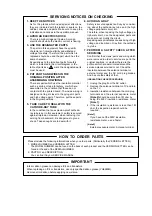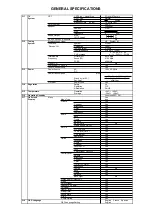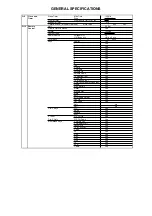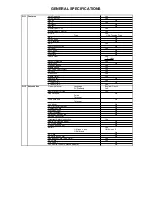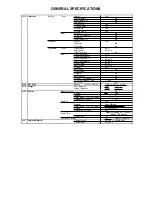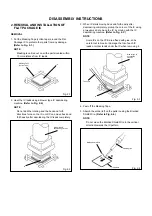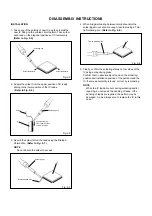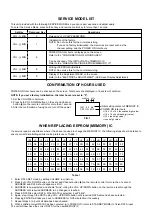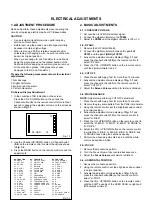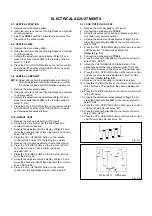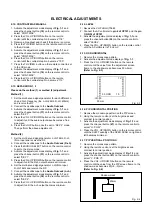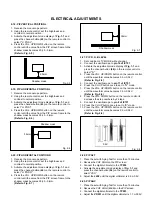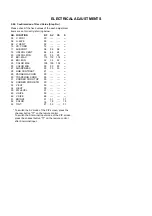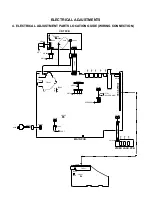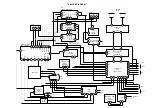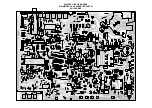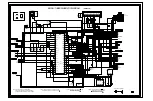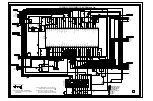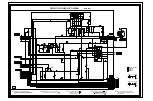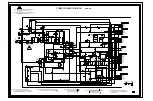
ELECTRICAL ADJUSTMENTS
FUNCTION
UNI COL CENT
UNI COL MIN
BRI. MAX
BRI. MIN
COLOR MAX
COLOR CENT
COLOR MIN
TINT
SHARPNESS
RGB CONTRAST
PARABOLA CORR
TRAPEZIUM CORR
CORNER CORR TOP
CORNER CORR BTM
V EHT
H EHT
FM LEVEL
LEVEL
SEPARATION 1
1. ADJUSTMENT PROCEDURE
Read and perform these adjustments when repairing the
circuits or replacing electrical parts or PCB assemblies.
CAUTION
•
•
•
•
Use an isolation transformer when performing any
service on this chassis.
Before removing the anode cap, discharge electricity
because it contains high voltage.
When removing a PCB or related component, after
unfastening or changing a wire, be sure to put the wire
back in its original position.
When you exchange IC and Transistor for a heat sink,
apply the silicon grease on the contact section of the
heat sink. Before applying new silicon grease, remove
all the old silicon grease. (Old grease may cause
damages to the IC and Transistor.)
2. BASIC ADJUSTMENTS
Prepare the following measurement tools for electrical
adjustments.
2-1: CONSTANT VOLTAGE
1.
2.
3.
Set condition is AV MODE without signal.
Connect the digital voltmeter to the TP002.
Adjust the VR502 until the digital voltmeter is 135
±
1V.
2-2: RF AGC
1.
2.
3.
4.
Receive the VHF HIGH (63dB).
Connect the digital voltmeter between the pin 5 of
CP101 and the pin 1 (GND) of CP101.
Activate the adjustment mode display of Fig. 1-1 and
press the channel button (02) on the remote control to
select “RF AGC”.
Press the VOL. UP/DOWN button on the remote control
until the digital voltmeter is 2.2V.
2-3: CUT OFF
1.
2.
3.
Place the set with Aging Test for more than 15 minutes.
Activate the adjustment mode display of Fig. 1-1 and
press the channel button (01) on the remote control to
select “CUT OFF”.
Adjust the Screen Volume until a dim raster is obtained.
2-5: FOCUS
1.
2.
3.
Receive the monoscope pattern.
Turn the Focus Volume fully counterclockwise once.
Adjust the Focus Volume until picture is distinct.
2-4: WHITE BALANCE
NOTE: Adjust after performing CUT OFF adjustment.
1.
2.
3.
4.
5.
6.
7.
Place the set with Aging Test for more than 10 minutes.
Receive the gray scale pattern from the Pattern Generator.
Using the remote control, set the brightness and contrast
to normal position.
Activate the adjustment mode display of Fig. 1-1 and
press the channel button (13) on the remote control to
select “R. BIAS”.
Press the CH. UP/DOWN button on the remote control to
select the “R. BIAS”, “G. BIAS”, “B. BIAS”, “B. DRIVE” or
“G. DRIVE”.
Adjust the VOL. UP/DOWN button on the remote control
to whiten the R. BIAS, G. BIAS, B. BIAS, B. DRIVE, and
G. DRIVE at each step tone sections equally.
Perform the above adjustments 5 and 6 until the white
color is looked like a white.
1. Oscilloscope
2. Digital Voltmeter
3. Multi-sound Generator
4. Pattern Generator
On-Screen Display Adjustment
1. In the condition of NO indication on the screen.
Press the VOL. DOWN button on the set and the
Channel button (9) on the remote control for more than 1
second to appear the adjustment mode on the screen as
shown in Fig. 1-1.
Fig. 1-1
TV
00 OSD 15
3.
4.
Use the Channel UP/DOWN button or Channel button
(0-9) on the remote control to select the options shown
in Fig. 1-2.
Press the MENU button on the remote control to end the
adjustments.
2-6: HORIZONTAL POSITION
1.
2.
3.
4.
Receive the monoscope pattern.
Using the remote control, set the brightness and contrast
to normal position.
Activate the adjustment mode display of Fig. 1-1 and
press the channel button (04) on the remote control to
select “H. POSI”.
Press the VOL. UP/DOWN button on the remote control
until the SHIFT quantity of the OVER SCAN on right and
left becomes minimum.
FUNCTION
OSD H
CUT OFF
RF. AGC
---
H. POSI
V. POSI
H. SIZE
V. SIZE
V. CENT
V. LIN
VS. CORR
G. DRV
B. DRV
R. BIAS
G. BIAS
B. BIAS
BRI. CENT
SUBCONT
UNI COL MAX
NO.
00
01
02
03
04
05
06
07
08
09
10
11
12
13
14
15
16
17
18
FUNCTION
SEPARATION 2
TEST STEREO
X-RAY
V POS U
V POS L
H POS L
H POS R
H SIZE
V SIZE
H POSI
R
G
B
BRIGHT
COLOR
TINT
VCO
PIP INPUT SELECT
READ DATA
NO.
38
39
40
41
42
43
44
45
46
47
48
49
50
51
52
53
54
77
88
Fig. 1-2
NO.
19
20
21
22
23
24
25
26
27
28
29
30
31
32
33
34
35
36
37


